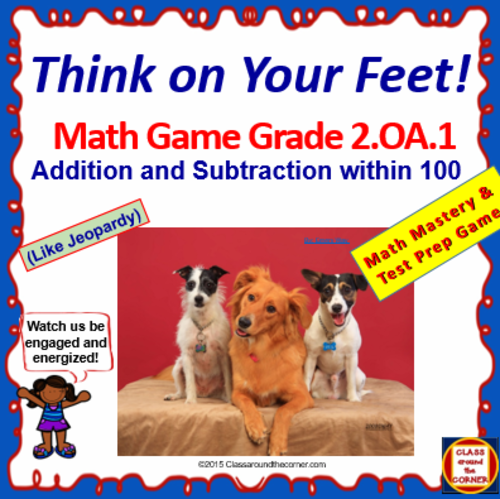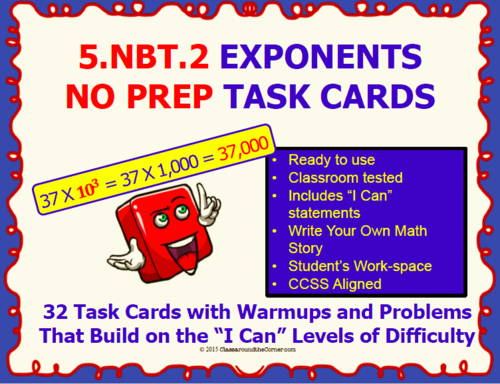
85Uploads
20k+Views
1k+Downloads

Grade 2 THINK ON YOUR FEET MATH! Interactive Test Prep Game—MONEY MASTERY 2.MD.8
Grade 2 THINK ON YOUR FEET MATH! Interactive Test Prep Game—MONEY MASTERY 2.MD.8
“Think on Your Feet!” Game – a better-than-Jeopardy interactive game to reinforce students’ practice and mastery of 2.MD.8 Solve word problems involving dollar bills, quarters, dimes, nickels, and pennies, using $ and ¢ symbols appropriately. —using pictures, symbols and words.
• Interactive PowerPoint designed for computer/doc camera and Smart Boards.
• No Prep format: Plug in computer and go.
• 25 engaging problems to promote fluency, collaboration and accountable talk.
• Two ways to master this math standard: 1. The class game. 2. Individual use or small groups recording the answers on a student answer sheet.
• Adherence to state and district standards.
~~~ Kid Tested—Educator approved: The feedback from TpT teachers and my fellow teachers at school, who use these grade-level interactive sets of task and game cards, state that kids are engaged and enthused; that the students are focused on the screen, calculating the problems, helping one another with the answers, laughing at the images and animations, and most of all – TALKING OUT LOUD ABOUT MATH.
We call it the “WOW” factor! ~~~
ACCOUNTABLE TALK: You will see your students become TEAM PLAYERS as they “talk it out” and problem-solve. They can pick an advisor, take a team vote or decide alone for the answers. The game provides immediate reinforcement of correct thinking about math.
The 20 word problems progressively develop the 8 “I can” statements and clarify the entire 2.MD.8.
I can identify dollar bills, quarters, dimes, nickels, and pennies.
I can give the value of dollar bills, quarters, dimes, nickels, and pennies.
I can use $ (dollar) and ¢ (cents) symbols correctly.
I can count money by combinations of coins up to 1 dollar.
I can count money by combinations of coins and bills up to 5 dollars.
I can count money by combinations of bills up to 100 dollars.
I can solve two-step word problems that use bills and coins.
I can apply math strategies that use money.
2.MD.8
Solve word problems involving dollar bills, quarters, dimes, nickels, and pennies, using $ and ¢ symbols appropriately.
Terms
51şÚÁĎ Â© Classaroundthecorner.com. All rights reserved by author. This product is to be used by the original purchaser only.
Personal Note
We want you to be satisfied with our products and we make sure we do everything in our power to provide you with quality resources. Any issues, suggestions, questions please email: Classaroundthecorner@gmail.com.
Check out other resources at my store at /teaching-resources/shop/classaroundthecorner.

65 ESSENTIAL LITERARY DEVICES QUESTION POSTERS AND TASK CARDS
65 ESSENTIAL LITERARY DEVICES QUESTION POSTERS AND TASK CARDS
(Aligned to Common Core, Webb’s Depth of Knowledge, and Backward Design)
A link to hundreds of “free to use” stories from the historic McGuffey Eclectic Readers is included.
This product covers five categories of Literary Devices:
Story Structure
Point of View and Theme
Tone and Mood
Literary Techniques
Unique Genres: Poetry and Drama
Here is a resource to connect kids daily to in-depth thinking and writing about reading. The rigorous questions are kid-friendly. The teacher can use a question to model thinking and get a lively collaborative discussion going in minutes. These 65 questions are not only for teacher modeling and collaborative discussion but also for paired interaction, and for independent journal writing. They correlate with “I Do,” “We Do,” “You Do” and can be adapted as essential questions or “Ticket Out” tasks.
Post them anywhere in your room, or print the task cards for students to use in groups, in centers, or for independent writing. Several posters can be placed together on a board so that you can refer to them throughout the week. The matching task cards will help kids focus on key concepts you are emphasizing in class. Spiral notebooks work well for students’ written responses to these types of questions. They are able to refer to pieces they have written to review concepts and to monitor their progress in writing about reading.
Teacher read-alouds are important again in the reading classroom. They give the teacher the opportunity to model thinking aloud as the story is read. These reading posters will provide a print-rich environment for your students. Kids will make connections between their thinking and the questions. They will get better at responding about reading.
Literary devices cover literary elements, such as theme, plot, point of view, tone, mood, and characterization. Literary devices also cover literary techniques, such as imagery, word choices, rhythm, rhyme, inferred meaning, and figurative language. These posters will help keep momentum high as students think about reading connections.
Included are reading reward coupons. The rewards are intended for expanded thinking and reasoning and for demonstrating improved depth of knowledge each week.
Other products related to writing about reading are: Story Elements Posters and Task Cards, Comprehension Strategies Posters and Task Cards, Informational Text Posters and Task Cards, and Literary Nonfiction Posters and Task Cards.
Check out other resources at my store at /teaching-resources/shop/classaroundthecorner.

58 ESSENTIAL LITERARY NONFICTION QUESTION POSTERS AND TASK CARDS
(Aligned to Common Core, Webb’s Depth of Knowledge, and Backward Design)
A link to hundreds of “free to use” stories from the historic McGuffey Eclectic Readers is included.
This product covers five categories of Literary Nonfiction:
Character Development
Point of View Order and Sequence
Setting
Conflict
Explain Relationships
Writer’s Craft
Reason and Evidence
Here is a resource to connect kids daily to in-depth thinking and writing about reading. The rigorous questions are kid-friendly. The teacher can use a question to model thinking and get a lively collaborative discussion going in minutes. These 58 questions are not only for teacher modeling and collaborative discussion but also for paired interaction, and for independent journal writing. They correlate with “I Do,” “We Do,” “You Do” and can be adapted as essential questions or “Ticket Out” tasks.
Post them anywhere in your room, or print the task cards for students to use in groups, in centers, or for independent writing. Several posters can be placed together on a board so that you can refer to them throughout the week. The matching task cards will help kids focus on key concepts you are emphasizing in class. Spiral notebooks work well for students’ written responses to these types of questions. They are able to refer to pieces they have written to review concepts and to monitor their progress in writing about reading.
Teacher read-alouds of non-fiction text is important in the reading classroom. Literary nonfiction (also referred to as narrative nonfiction) gives the teacher the opportunity to model thinking aloud about text structure and text features.
Literary non-fiction text for grades K-5 covers biography and autobiography. For grades 6-12 it broadens to include essays, speeches, and memoir. Questions here relate to making personal and textual connections, asking about content, accuracy, relevance, style, text structure and features. Literary nonfiction text relates literature by placing importance on description, sequence or time/order, compare/contrast, cause and effect, and problem/solution. These posters will help keep momentum high as students think about reading connections.
Included are reading reward coupons. The rewards are intended for expanded thinking and reasoning and for demonstrating improved depth of knowledge each week.
Other products related to writing about reading are: Literary Devices Posters and Task Cards, Comprehension Strategies Posters and Task Cards, Informational Text Posters and Task Cards, and Story Elements Posters and Task Cards.
Check out other resources at my store at /teaching-resources/shop/classaroundthecorner.

58 ESSENTIAL INFORMATIONAL TEXT QUESTION POSTERS AND TASK CARDS
(Aligned to Common Core, Webb’s Depth of Knowledge, and Backward Design.)
A link to hundreds of “free to use” stories from the historic McGuffey Eclectic Readers is included.
This product overs five categories of Informational Text:
Text Features
Explain Relationships
Reasons and Evidence
Text Structure
Integrate Information
Here is a resource to connect kids daily to in-depth thinking and writing about reading. The rigorous questions are kid-friendly. The teacher can use a question to model thinking and get a lively collaborative discussion going in minutes. These 58 questions are not only for teacher modeling and collaborative discussion but also for paired interaction, and for independent journal writing. They correlate with “I Do,” “We Do,” “You Do” and can be adapted as essential questions or “Ticket Out” tasks.
Post them anywhere in your room, or print the task cards for students to use in groups, in centers, or for independent writing. Several posters can be placed together on a board so that you can refer to them throughout the week. The matching task cards will help kids focus on key concepts you are emphasizing in class.
Teacher read-alouds of non-fiction text is important in the reading classroom. Informational text gives the teacher the opportunity to model thinking aloud about text structure and text features. These reading posters will provide a print-rich environment for your students. Kids will make connections between their thinking and the questions. They will get better at responding about reading.
Informational text questions include making personal and textual connections, asking about content, accuracy, relevance, style, text structure and features. Informational text demonstrates predominantly expository structures, which may include arguments, opinions, and information/explanation. Expository text relates to description, sequence or time/order, compare/contrast, cause and effect, and problem/solution. You will see that there are similarities here with the components of literature. These posters will help keep momentum high as students think about reading connections.
Included are reading reward coupons. The rewards are intended for expanded thinking and reasoning and for demonstrating improved depth of knowledge each week. As a result of the teacher modeling thinking and writing, students will become more confident and polished writers. The rewards are for the great ideas you will see kids express on paper.
Check out other resources at my store at /teaching-resources/shop/classaroundthecorner.

66 ESSENTIAL STORY ELEMENTS QUESTION POSTERS AND TASK CARDS
(Aligned to Common Core, Webb’s Depth of Knowledge, and Backward Design.)
A link to hundreds of “free to use” stories from the historic McGuffey Eclectic Readers is included.
This product covers five categories of Story Elements:
Setting
Character
Plot
Conflict
Reader’s Connection
Here is a resource to connect kids daily to in-depth thinking and writing about reading. The rigorous questions are kid-friendly. The teacher can use a question to model thinking and get a lively collaborative discussion going in minutes. These 66 questions are not only for teacher modeling and collaborative discussion but also for paired interaction, and for independent journal writing. They correlate with “I Do,” “We Do,” “You Do” and can be adapted as essential questions or “Ticket Out” tasks.
Post them anywhere in your room, or print the task cards for students to use in groups, in centers, or for independent writing. Several posters can be placed together on a board so that you can refer to them throughout the week. The matching task cards will help kids focus on key concepts you are emphasizing in class.
Teacher read-alouds are important again in the reading classroom. They give the teacher the opportunity to model thinking aloud as the story is read. These reading posters will provide a print-rich environment for your students.
This resource covers varied questions relating to story elements: setting, characters, plot, conflict, and reader’s connection. These questions will help students connect what they know to what they are reading—resulting in their ability to analyze, appreciate, and interpret literary text.
Included are reading reward coupons. The rewards are intended for expanded thinking and reasoning and for demonstrating improved depth of knowledge each week. As a result of the teacher modeling thinking and writing, students will become more confident and polished writers.
Check out other resources at my store at /teaching-resources/shop/classaroundthecorner.







